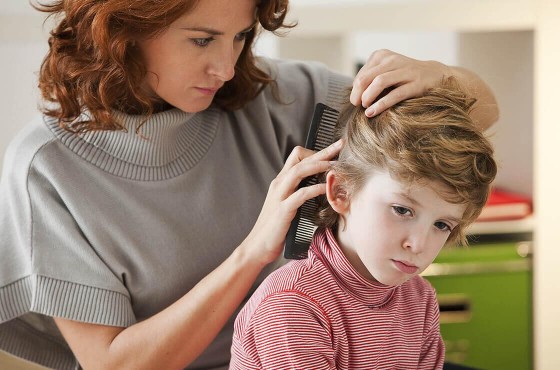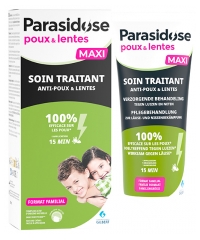Lice:
everything you need to know to get rid of them
Written by Paul Musset, Doctor in Pharmacy | published on | updated on 15/04/2024

Every year, at the beginning of the school year, it’s the same thing. The children see each other again, have fun, come into close contact, and in the following weeks, they once again have lice in their hair. Then parents begin their merciless fight to get rid of them. How do these little bugs multiply so quickly? How can you recognise them and how can you get rid of lice and nits effectively? Is it possible to avoid them?
Lice: Small insects with a high rate of contamination
The various phases of the life of a louse
A louse is a parasitic insect. It has a lifespan of between 30 and 40 days. During this period, it will evolve through three stages:
- Nits: Eggs laid by the female louse attach to the base of the hair shaft thanks to the insect secreting something called spumaline. The eggs hatch after 7-8 days, bringing this phase to an end.
- Nymphs: This is the intermediate stage after hatching which lasts about 10 days and during which the insect moults three times.
- Adult lice: The final stage of a louse’s life that triggers the reproductive phase, which can last more than three weeks before the insect dies.
Is having lice synonymous with poor hygiene?
For head lice, the answer is no. This common misconception may come from the association of the familiar term “flea-ridden” used to describe a person with questionable hygiene.
In reality, this term refers more to pubic lice, also known as crabs. Head lice do not differentiate between clean, greasy or dirty hair. What interests these little bugs above all is the warmth of the scalp and access to their favourite food: blood. Lice are haematophagous insects.
Why is contamination so fast?
An adult female louse can lay up to ten eggs per day, or about 300 nits throughout its life. Moreover, the simple contact of a contaminated head with a healthy head can allow the lice to sneak onto the unaffected hair. Moreover, a single female louse is all it takes to infest an entire head.
Transmission can also occur due to contact with an external element such as a cap, scarf, or even a sofa cushion or pillow. A louse not living on a person’s head cannot feed on blood and can only survive for 24 to 72 hours.
An itchy head? How can you tell if it is due to nits or lice?
Warning signs
The most common symptom that indicates the possible presence of lice is a severely itchy head. But what causes this? Simply the bites in the scalp caused by the small insects when they feed.
However, an itchy head does not necessarily mean lice. Other reasons can cause itchiness, such as an irritated scalp or the presence of simple dandruff (dry particles due to the epidermis renewing itself too rapidly).
Tips to confirm the presence of parasites. Where do they like to stay?
Lice really like heat. The ideal temperature for their comfort is 32 °C. That is why they often take up residence mainly at the neck and behind the ears. Those are the first places to inspect.
What’s the difference between nits and dandruff?
As soon as we see a white particle on our children’s heads, we are overwhelmed by a sense of dread. What if it’s a nit? Nothing could be easier than finding out for sure:
- Does the particle slide easily along the hair shaft? It’s dandruff.
- Does it hold tight? Chances are it’s a nit.
Anti-lice treatments
The best ways to get rid of an infestation
Shampoos and haircare treatments
These are the most common treatments. The most commonly used active substance is dimethicone. This substance kills the lice by asphyxiating them. Some treatment products sold at Cocooncenter, such as Pouxit XF Anti-Lice and Nits combine this substance with penetrol for better penetration.
After applying the product and letting it set for about 15 minutes, simply wash the hair with a mild shampoo to remove the product. The absence of alcohol and insecticide ensures it is safe to use on pregnant women and young children over the age of six months.
Lice combs
These are to be used in addition to an anti-lice treatment. Once the treatment has been applied and rinsed, a lice comb can be used to easily remove any remaining lice and nits thanks to its microgrooved teeth.
An electronic version of lice combs is also available, such as the Visiomed Zap’x Electronic Anti-Louse Comb VM-X100.
This alternative to haircare treatment makes it possible to remove the lice thanks to a small electrical shock that is imperceptible and harmless to humans.
Did you know?
Natural and very economical solutions also have the power to fight lice. For instance, white vinegar can be diluted in the rinse water to enhance the effectiveness of the treatment. It can also be used pure, avoiding any contact with the face, as it is a very irritating product.
Solutions to avoid an invasion: The main preventive treatments
The repellent power of lavender
Lavender has antimicrobial properties. That is why it has the power to keep small parasites away from your children’s heads. It is regularly found in lice prevention products. It can also be used directly in the form of an essential oil, provided that the precautions for use (age of the child, risk of allergy, etc.) are strictly observed.
Sprays
Composed of active ingredients that are more often than often of natural origin such as citriodiol (known for its repellent qualities against biting insects), they promise up to twelve hours of protection of the hair. To optimise their effectiveness, they should be sprayed in the morning over all the hair, especially behind the ears and at the neck.
Anti-lice tip:
To increase the chance of protection during the infestation period, add three drops of lavender essential oil to your child’s shampoo (from three years old).
Lice are not dangerous in themselves for your health. However, itching can become painful and strongly irritate the scalp. To prevent contamination, do not hesitate to inform the relatives of the child concerned (school, family, friends). They can be warier and make the necessary arrangements to avoid infestation.
Three key points about lice:
- Lice does not mean poor hygiene;
- Lice like warmth and nest easily in the neck and behind the ears;
- Lavender is an excellent natural way of prevention.
























